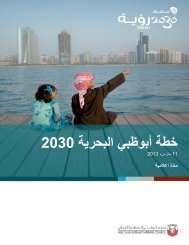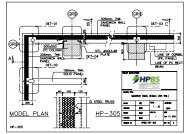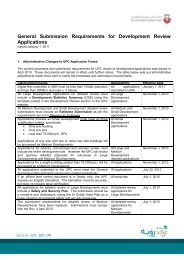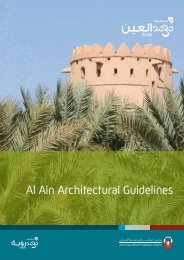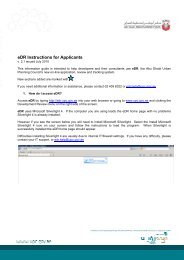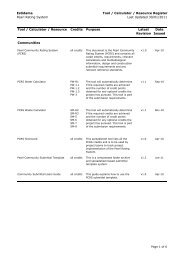Vision Magazine Online Issue 1
Vision Magazine Online Issue 1
Vision Magazine Online Issue 1
Create successful ePaper yourself
Turn your PDF publications into a flip-book with our unique Google optimized e-Paper software.
The UPC undertook rigorous research to create an<br />
urban structure framework plan to ensure Abu Dhabi<br />
can cater for its anticipated economic and population<br />
growth over the next 20 years. Work began in<br />
December 2006 with a series of evaluation exercises<br />
and preparatory analysis. This comprised economic<br />
analysis, including projecting the main sectors that will<br />
contribute to economic growth, as well as population,<br />
employment and tourism forecasts. It also included<br />
a review of Abu Dhabi’s existing infrastructure and<br />
transportation capacity.<br />
Then in February and March 2007, the UPC organised<br />
a series of 'charrettes'. These brought together local,<br />
regional and international urban planning experts to<br />
debate and discuss the best ways to expand the city<br />
of Abu Dhabi, so it can accommodate the predicted<br />
population and economic growth while becoming a<br />
more vibrant and liveable city.<br />
The economic and demographic analysis projected<br />
that Abu Dhabi’s population will more than triple from<br />
930,000 in 2007 to 3.1 million in 2030. Meanwhile,<br />
the number of tourist visits to Abu Dhabi is forecast to<br />
grow from 1.8 million in 2007 to 7.9 million in 2030.<br />
This high level of growth needs to be accompanied by<br />
an increase in accommodation to house the growing<br />
number of residents and tourists. Capital 2030 has<br />
calculated that Abu Dhabi will need 686,000 residential<br />
units in 2030. In 2007 it only had 180,000 homes. It<br />
also needs to boost the number of hotels rooms from<br />
10,000 in 2007 to 74,500 in 2030.<br />
Of course, all these new people will only come to Abu<br />
Dhabi if they can find jobs. Capital 2030 is therefore<br />
closely aligned with the Abu Dhabi Economic <strong>Vision</strong><br />
2030, which sets out economic targets that have<br />
been prepared by the Economic <strong>Vision</strong> Taskforce and<br />
approved by the Abu Dhabi Executive Council.<br />
It is important that the<br />
growth of Abu Dhabi is<br />
managed in a<br />
co-ordinated and<br />
sustained way<br />
H.E. Falah Al Ahbabi,<br />
General Manager,<br />
Abu Dhabi Urban Planning Council<br />
To meet these economic targets, Capital 2030 has<br />
calculated how much commercial space is required to<br />
accommodate the necessary businesses to grow the<br />
economy and create jobs. It estimates that Abu Dhabi<br />
needs to treble the amount of office and industrial<br />
space for warehouses and factories by 2030. This<br />
means creating more office space and industrial space<br />
to accommodate future needs.<br />
All these new residents, employees and tourists also<br />
need places to shop and spend their leisure time. Retail<br />
space, cinemas, restaurants and even golf courses<br />
have been factored into Capital 2030.<br />
In addition, community amenities such as schools,<br />
hospitals, clinics, playgrounds and parks also need to<br />
be provided to keep pace with the growing population.<br />
For instance, Capital 2030 forecasts that the city will<br />
need 650 schools and 10,000 hospital beds to serve<br />
the enlarged population in 2030. The delivery of<br />
infrastructure for basic amenities, such as water, sewage,<br />
power and telecommunications, has also been planned.<br />
More people means more traffic, so Capital 2030<br />
includes an integrated transport strategy that includes<br />
building new roads and parking facilities to improve<br />
traffic flows, but also proposes the development<br />
of cycle lanes and new public transport networks,<br />
including an underground metro and overland tram, to<br />
offer an alternative to the car.<br />
This amounts to a lot of required development and<br />
new infrastructure. The Urban Structure Framework<br />
Plan is therefore a vital document to ensure Abu Dhabi<br />
meets its growth forecast, but in a measured and<br />
sustainable way.<br />
Abu Dhabi Island is not big enough to house this<br />
huge growth in population and to accommodate<br />
all the necessary business, leisure and community<br />
developments. Capital 2030 has identified locations<br />
where the city will expand. These include many<br />
surrounding islands.<br />
For instance, the 27 square kilometre Saadiyat Island has<br />
been identified as Abu Dhabi’s new cultural heart. It will<br />
be home to the new Zayed National Museum, the Louvre<br />
Abu Dhabi and the Guggenheim Abu Dhabi Museum. But<br />
it will also be home to 160,000 residents with all the<br />
necessary community, retail and leisure facilities.<br />
Sowwah Island has been designated as the heart of Abu<br />
Dhabi’s new Central Business District. The 105 hectare<br />
island will accommodate much of the necessary new<br />
office accommodation for blue chip companies and<br />
have a daily working population of 75,000 as well as<br />
being home to 30,000 residents. Meanwhile, Yas Island<br />
has already become a key entertainment location. The<br />
25 square kilometre island played host to the inaugural<br />
Formula 1 Etihad Airways Abu Dhabi Grand Prix, and it<br />
will also open the world’s first Ferrari World theme park<br />
later this year as well as other entertainment and leisure<br />
venues and hotels.<br />
Meanwhile, Capital 2030 has identified the proposed<br />
Capital District, located between Khalifa City A and<br />
Khalifa City B and Mohammed Bin Zayed City, as a<br />
second centre for the city. The 4,900 hectare new<br />
district will act as the federal seat of government<br />
and accommodate the majority of Abu Dhabi’s<br />
government departments, foreign embassies as well<br />
as being home to 370,000 residents.<br />
10 VISION MAGAZINE - ISSUE ONE



